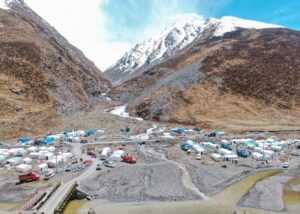 China has released its 14th Five Year Plan (2021-25) which has revealed several projects focused on infrastructural development in Tibet, including the militarisation of border regions, as reported by Tibetan Review.
China has released its 14th Five Year Plan (2021-25) which has revealed several projects focused on infrastructural development in Tibet, including the militarisation of border regions, as reported by Tibetan Review.
Currently, large stretches of grasslands which have been home and livelihood to nomads for generations, have been converted into military basecamps and Tibetans living in these border regions of Shigatse, Dingri County, Gampa County, Ngamring County, Ruthok County and Nyalam County are being forcefully relocated and warned against sharing news of the relocation.
Free Tibet, the British based Tibet support group, reports that in February the authorities in Dingri held meetings with the local community to warn them that sharing information – or “spreading rumours”, as sharing of information is perceived by the Chinese Communist Party (CCP) – would lead to punishment by law as well as termination of all relocation compensations, including water and grass. Nomads who are relocated have been promised ten years of compensation.
 Free Tibet’s anonymous source in Tibet has said that families in Dingri have been under investigation by the police and coerced into convincing relatives residing in exile to return to the community. Any disagreeing individual would be penalised, their names removed from the “family register” and their quota of land possessed by the government for farming purposes.
Free Tibet’s anonymous source in Tibet has said that families in Dingri have been under investigation by the police and coerced into convincing relatives residing in exile to return to the community. Any disagreeing individual would be penalised, their names removed from the “family register” and their quota of land possessed by the government for farming purposes.
Forceful displacement in eastern Tibet has been in effect since 2006, when China instructed provincial governments to oversee effective relocation. In 2011, the Tibet Autonomous Region* (TAR) administration, upon order from the central authority in China, undertook the responsibility to complete relocation within ten years, urging nomads to return land to Chinese authorities in exchange for ten years of compensation.
However, previous accounts of the relocation policies and actions have proven that no promises of compensation, jobs, health care have been upheld, as reported by Free Tibet and Tibetan Review.
The Five Year Plan includes provision for other military projects including extensions to highways to the borders and high-speed railway networks, including connecting Lhasa with Chengdu over the border in China and headquarters of the local military command. At least 20 new border airports are planned in the TAR, and the Tibetan Review quotes Jayadeva Ranade, former Indian Cabinet Secretariat’s China expert, as saying “In just over a decade, China will have a much-improved strategic border defence infrastructure”.
*The Tibet Autonomous Region, formerly part of the independent country of Tibet, was established in 1965 as an autonomous region of China, governed from Beijing.




 Print
Print Email
Email